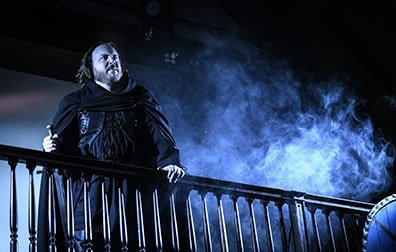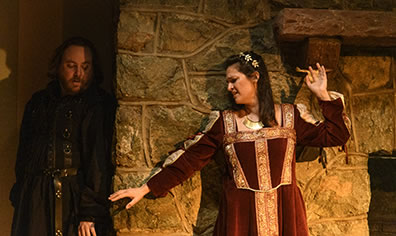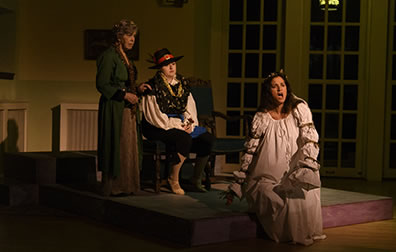Hamlet
Hark! How These Angels Sing
Shakespeare Opera Theatre, Grace Episcopal Church, The Plains, Virginia
Sunday, February 9, 2020, Middle of three rows
Directed by Lori Lind

Hamlet (Michael Reid) addresses the Ghost of his father in the Shakespeare Opera Theatre's production of Hamlet, the play by William Shakespeare and the opera by Ambroise Thomas, at Grace Episcopal Church in The Plains, Virginia. The company specialiizes in presenting Shakespeare's works with classical music his plays inspired. Photo by Kenneth Garrett, Shakespeare Opera Theatre.
My parents and I shared similar cultural tastes, including Shakespeare, though I came to the Bard independently of their lifelong appreciation for his works. They influenced my love for classical music, and my brothers and I turned them on to rock ‘n’ roll. Dad devoted a sermon preaching the gospel of Jethro Tull at the U.S. Air Force’s Advanced Chaplain’s School (to the shock of his colleagues), and Mom accompanied me to a Bruce Springsteen concert (The River tour). They especially loved opera, but that was the one genre I couldn’t cotton to.
Dad would play Wagner with the hi-fi at 11—the walls vibrated. In college I gave opera another try, using Wagner’s works as the topic for a folklore class term paper, sitting through hours and hours (Wagner operas are loooooong) of bombastic music. Still no affection. Through my years as a professional music critic, I came to appreciate operatic skills but yet did not develop a taste for the art form. I also discovered my opinion was shared by some of the rock and country musicians I covered, who told me they liked “all types of music, except opera.” Yes! Legitimacy! I had records of everything from Italian folk rock, Japanese jazz, and Indian ragas to bluegrass and Beethoven, but zero opera—not even Beethoven’s Fidelio. In my 30s I finally expanded my appreciation of opera to the music itself. Then, my father got through to me. After Mom died, I, being the good son, accompanied Dad to a Met Live production of Giacomo Puccini’s Madam Butterfly and had the transformative moment that great art can lay on a man.
All of which comes into play every time I attend a Shakespeare Opera Theatre performance, the company's current production of William Shakespeare’s and Ambroise Thomas’s Hamlet being my fourth. Shakespeare Opera Theatre productions can expand your Shakespearean dimensions (sometimes to a frustrating extent, as with Hamlet) while exposing you to opera’s prevailing glory, especially those pieces, well known or not, inspired by Shakespeare.
Based in The Plains, Virginia, just beyond the National Capital Region’s western suburbs, the Shakespeare Opera Theatre was founded in 2015 by opera singer, arranger, and conductor Lori Lind, who directed Hamlet. Though she originally staged repertories—Shakespeare’s Much Ado About Nothing and Hector Berlioz’s Béatrice and Bénédict, The Merry Wives of Windsor and Giuseppe Verdi’s Falstaff—her modus operandi the past three years has been to combine Shakespeare’s work with musical composition it inspired: Felix Mendelssohn for A Midsummer Night’s Dream and Berlioz for Romeo and Juliet. She does the same with Hamlet.
With my schedule fully booked through the production’s public run, Lind invited me to attend a preview performance. My wife, Sarah, and I made up two-thirds of this night’s audience in the fellowship hall of The Plains Grace Episcopal Church, and Lind and the cast came out after the show to talk with us. My observations include issues, such as textual cuts and pacing, that might have been part of the preopening process of mounting a production.
Despite being an out-of-the-way destination, the beautiful and historic Grace Episcopal is a perfect venue for the Shakespeare Opera Theatre. Though the fellowship hall has a stage, our seats face the opposite direction, toward a large fireplace under a balcony that serves as the rampart where Hamlet meets his father’s Ghost (the actor playing the Ghost dropped out, so Michael Reid’s Hamlet talks to empty space as Gene Allen, who otherwise plays Claudius, reads the Ghost’s lines from back stage). In front of the hearth is a banquet table, and two thrones set on a two-tiered platform are off to one side. Lind dresses the cast in opera-opulent costumes, a fairy-tale blend of Medieval and Renaissance fashions. To the left of the audience is the “orchestra,” a quartet under Lind’s direction. The acoustics are fabulous and combine with the quality voices of the cast to transport you aurally to the Met in New York. Lind likes to begin a scene with the cast singing off stage—from the hallway behind us to the chambers behind the fireplace—and she uses that trope in staging the opera’s peasant festival (the setting for Ophelia’s mad scene) to open the production’s second half in a spine-tingling surround-sound sensation.
Lind’s first challenge with Hamlet is who’s Ambroise Thomas? I had never heard of Thomas before I saw this production’s playbill and was totally unfamiliar with any of his works. The 19th century French composer wrote several operas, but only his Mignon (1866) and Hamlet (1868) have managed to achieve any fixture in opera repertories, the latter giving baritones the opportunity at a juicy lead role (Reid, who says he has a showtune voice at best, sings only a few lines from the opera in this mashup). Thomas was capable of scoring some beautiful melodic moments, and does so in Hamlet, but the opera generally fails to grasp the existential core and psychological essence of Shakespeare’s play. In fact, the opera ends with the Ghost showing up at Ophelia’s funeral, finally prompting Hamlet to kill Claudius. Nobody else dies, and Hamlet becomes king, ta-DAHHH!
Librettists Jules Barbier and Michel Carré chose melodrama over drama and turn Prince Hamlet into a directionless wuss while even in darker moments Thomas’s tunes occasionally resemble a Dudley Do-Right soundtrack. Exacerbating this to my ear is the composition of the quartet: Lisa Bloy on piano, Drew Robertson on violin and viola, Mary Riddell on oboe, and Julianne Geyser on flute. All are suitably skilled musicians, but the prevalence of upper range instruments doesn’t adequately embrace the occasional majestic moments in Thomas’s score; I missed the depth that a horn or cello might have provided.
Though the majority of Hamlet's part is Shakespeare’s rather than Thomas's in Lind's staging, Reid’s portrayal is handcuffed by the opera, both stylistically and logistically. He makes a dramatic entrance after the production, per Thomas, opens with the procession of newly crowned King Claudius and incumbent Queen Gertrude (Maggie Ramsey) to a full chorale. Hamlet is notably absent: notably because Gertrude interrupts the chorus to sing a line wondering where her son is, and Claudius replies in song to hush and bear herself more queenly. As the opera processional concludes, the production takes up Shakespeare’s play with Claudius tending to Laertes (Amos Warren making his post-college regional debut). Then, looking beyond us to see, with some surprise, that Hamlet has arrived. “But now, my cousin Hamlet," Claudius says, "and my son—."
“A little more than kin and less than kind,” Hamlet says, Reid speaking from behind us, not only announcing the character’s dramatic arrival but the actor’s, too. Reid is good with the verse, and he captures as much of Hamlet’s tortured soul as he can, especially in his relationship with Ophelia. He tries to make Hamlet an action hero, but the opera won’t let him, and he can do no more with Hamlet's psychosis than the actual material he’s given. Much of the play is truncated, in part by Thomas who cut out all of the Fortinbras subplot and Rosencrantz and Guildenstern, too, while expanding Ophelia’s role. To keep the production at about three hours including intermission, Lind hacks matter from both opera and play. The bulk of Hamlet’s scene with the Ghost is gone. Laertes’ two Act Four scenes are telescoped into one, thus losing his digression into his own kind of madness. Key plot points get cut, such as Hamlet’s statement that he will put on an antic disposition and his planning out the mousetrap. Even the “To be or not to be” soliloquy gets the ax 15 lines in. In addition to the textual cuts and the opera’s shadings of the character, Reid’s Hamlet sometimes must move in slow motion to wait out a musical interlude or an Ophelia aria.
To be sure, Lind has a strong affinity for Shakespeare—it is the first word in her theater company’s name—and even when combining works she earnestly aims for fealty with Shakespeare’s texts and intents (so, yes, Hamlet dies at the end, as do Gertrude and Laertes, as well as the king). She also brandishes solid Shakespeare bona fides by casting G. Michael Harris, her lone equity actor, in as many productions as she can. He plays Polonius, and as he did with his Falstaff and Bottom in previous Shakespeare Opera Theatre productions, Harris combines exquisite comic skills and empathy to turn his roles into freshly revealing portraits of human characters. Polonius’s precepts to Laertes are genuinely good advice, as Harris points out after the show, and to play them any other way than as a loving father undermines the relationships that are fundamental to subsequent action in the play: Ophelia’s slide into insanity upon her father’s murder, and Laertes’s single-minded pursuit of revenge. As Polonius gets to the last of his precepts, Harris gives us a glimpse of the man’s tragic path. “To thine own self be true. And it must follow, as the night the day, thou canst not then be false to any man,” he says, advice that Polonius himself fails to heed when proximity to power beckons. Indeed, in the opera, Polonius is complicit in the elder Hamlet’s murder, a fact revealed to both the audience and the eavesdropping Hamlet at the end of Claudius’s prayer scene (Lind keeps this operatic passage in her production, which means Harris finally gets to do a little singing in a Shakespeare Opera Theatre show).


Top, Ophelia (Christina Phillips) sings an aria as she reaches for the hiding Hamlet (Michael Reid) in the Shakespeare Opera Theatre's production of William Shakespeare's and Ambroise Thomas's Hamlet. Above, Phillips plays Ophelia in the mad scene with Osric (Jessica Adkins) and the Lady in Waiting (Helen Woodson) watching. Phillips and Adkins alternate playing Ophelia and Osric from performance to performance. Photos by Kenneth Garrett, Shakespeare Opera Theatre.
Harris applies his comic skills to great effect when he reads for Claudius and Gertrude Hamlet’s letter to Ophelia. “Beautified is a vile phrase,” Polonius says, but it gets worse, apparently, for after he gets to “her excellent white bosom,” Harris’s Polonius becomes so alarmed he covers half of the letter with one hand and summarizes the pornographic matter as “et cetera” while finding the more pertinent and suitable stuff to read to the king and queen. That includes the famous quatrain, “Doubt thou the stars are fire, doubt that the sun doth move, doubt truth to be a liar, but never doubt I love,” which the opera uses as a key motif through to the last line of Ophelia’s life.
Though Shakespeare is the first word in this company’s name, “Opera” is rightly that name’s centerpiece, what sets it apart from all other Shakespearecentric theaters. That fact, as always with Lind’s productions, is the overwhelming strength of this Hamlet. Other than Harris and Christina Phillips, the acting is uneven, but the vocals are solid, both in ensemble and most individual roles. Two singers in one role, Ophelia, stand out—and initial credit goes to Thomas, who enhanced the young maid’s role and gave her two magnificent arias and two captivating duets.
The aforementioned Phillips and Jessica Adkins are alternating the roles of Ophelia and Osric from show to show during the production’s run, but for this preview performance they switch off at intermission. Phillips leads off, sparking my admiration in her acting chops and mesmerizing me first in her duet with Laertes and then with her aria leading into her pivotal encounter with Hamlet and through the nunnery scene. At the interval, I expressed to Sarah my disappointment that she wouldn’t continue as Ophelia; that proved a premature opinion as Adkins takes Ophelia to stunning heights in her mad scene, not just emotionally but vocally, too, nailing—and I mean nailing—a G over high C. If you want to experience this double dose of operatic magnificence, you'll need to see two shows. Whichever singer is not playing Ophelia perform's Osric's aria at the play's climax, wrapped around Horatio (Amy Baska) eulogizing Hamlet: “Now cracks a noble heart. Goodnight, sweet prince, and flights of angels sing thee to thy rest!”
Never was that line spoken more truly than here.
Eric Minton
February 20, 2020
Comment: e-mail editorial@shakespeareances.com
Start a discussion in the Bardroom



 Find additional Shakespeareances
Find additional Shakespeareances